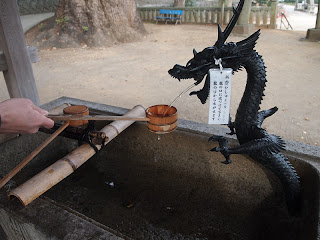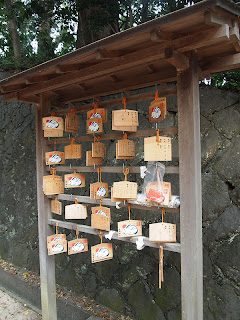A few weeks ago, my friends and I visited Hakone, one of the most attractive tourist spot of Japan. Now that we talk about Hakone, there are many, many famous spots that everyone already knows about. I therefore will write about something that many tourists may not have thought about visiting, but is still a nice place to visit nevertheless.

The place I visited is called "Hakone Open-Air Museum", which, according to the source I read before my trip, is a place where art and nature are successfully combined. The place has sculptures and other artistic work being displayed on an open ground, with surrounding mountains as a background.
The museum is located within a walking distance from Hakone's Chokokunomori train station. All you need to do is getting off a train at this station and follows everyone else, as it is most likely that they are going to visit this place as well.
Before entering the museum, you will be greeted with this nice-looking fountain, which keeps rolling on and on as water runs through it.
And I do love this entrance into the museum. It's accessed by using an escalator down to the ground on which the museum was built. Riding a very modern-looking escalator in the middle of valleys and mountains is indeed a really nice feeling - something only Japan can offer.
After entering the museum, what you'll see is the plaza/garden area with lots of sculptures on display.
Being an extremely diligent blogger that I am, I would love to describe the artistic pieces that can be found there in details. However, I realized that it is best to let those who will visit the place experience the entire atmosphere by themselves, and telling them everything right here would partly ruin the fun.
Now, without spoiling all the readers about the main highlights' there, I will refrain from explaining things in words and show you all some pictures I took on that day (as examples of what you can expect to see) instead:
Now, without spoiling all the readers about the main highlights' there, I will refrain from explaining things in words and show you all some pictures I took on that day (as examples of what you can expect to see) instead:
For me, the highlight of this place is definitely the piece called "Woods of Net",which is a huge bird's nest-like hammock thing knitted from soft materials. A perfect place for parents to put their children (who wouldn't be able to understand any other artistic pieces anyway) and allow them to climb and roll inside this thing as much as they want. Actually, this looks like so much fun that if there is no adults around, I would have an irresistible urge to climb on it as well.
Hakone is famous for its "Onsen" (hot spring). There is an Onsen here as well. It may be for your foot only, but it's still Onsen nevertheless.
Another highlight is the "Symphonic Sculpture" created by Gabriel Loire. This piece is a rather high tower, with the inside wall decorated by stained glass. If you haven't taken picture of this place, then you haven't really reached the museum yet.
 |
| The view from the top of the tower |
My impression about the place is that, if you do appreciate art, beautiful scenery, and taking a lot of photos, then this is the place for you.
However, I can't say that the artistic pieces here will make an impression on all the viewers. While I was looking at one of the sculptures (of something I don't really know), a Japanese man standing beside me utter "Wakaranai" (I don't understand this) to his friend, and I must say that I quite agreed with him, as many arts on displayed here are not something that everyone will understand (I don't either).
 |
| A building with Picasso's arts on display |
 |
| The cafe inside the museum. Do try ice-cream. It's quite pleasurable. |
Nevertheless, Hakone Open Air Museum is a very beautiful, artistic and interesting place to see. It has a certain unique (and very Japanese) way of combining modern arts and nature nicely. It is also a great pleasure to see how much is invested in displaying these works of art. For me, it truly shows how much importance and respect the artists receive here.
The next place on my list is the "Hakone Museum of Art". From the name alone, it does sound similar to the Open Air Museum mentioned above, but the main attraction of this place is actually its garden.
The front of the Museum of Art contains a very traditional and Japanese-looking moss garden, with the ground all covered in fluffy moss and even the rocks are perfectly arranged. According to the pictures I've seen in the pamphlets, the look of this garden will dramatically change according to the seasons. For example, all the trees' leaves will turn to orange during the fall, and the ground will be covered with snow during winter.
Unfortunately, at the time of my visit only 2-3 of the trees have turned into autumn color. In this kind of situations, my suggestion is to take tons of close-up pictures of those trees, and act as if all the trees have turn into such color when you show the photos to your friends. ;-)
Unfortunately, at the time of my visit only 2-3 of the trees have turned into autumn color. In this kind of situations, my suggestion is to take tons of close-up pictures of those trees, and act as if all the trees have turn into such color when you show the photos to your friends. ;-)
 |
| The moss garden |
Aside from the moss garden, the Hakone Museum of Art also offers the Sekirakuen Garden, which is opened only on weekends, holidays and everyday during November. The garden is located on the hill's slope and is creatively decorated with stones and waterfalls. Fall is definitely the highlight season here, but visiting this place during winter, when the slope is covered with snow, should be a great experience as well.
Moving on to the actual museum, the main building is one with a Chinese-style tiled roof. Inside, you can find many Japanese ancient arts, artifacts, potteries, and other cultural objects on display. But all in all, the most impressive part of this museum is definitely the garden itself.
Now that there is not much else to see, I'll leave you with the last set of the photos I took during my visit to both places. It has been a great travelling experience for me, and the fact that both places were not crowded with tourists made it even better.
Access:
-Hakone Open Air Museum: The museum can be reached in a short walk from Chokoku No Mori Station on the Hakone Tozan Railway (30 minutes, 390 yen from Hakone-Yumoto, covered by the Hakone Free Pass), the last station before the terminal station of Gora.
-Hakone Museum of Art: The museum is located on the slopes of Gora, just above Gora Park. It is a three minute walk from Koenkami Station of the Hakone Tozan Cablecar between Gora and Sounzan, or a ten minute walk uphill from Gora Station.
Source: http://www.japan-guide.com/e/e5200.html












































































